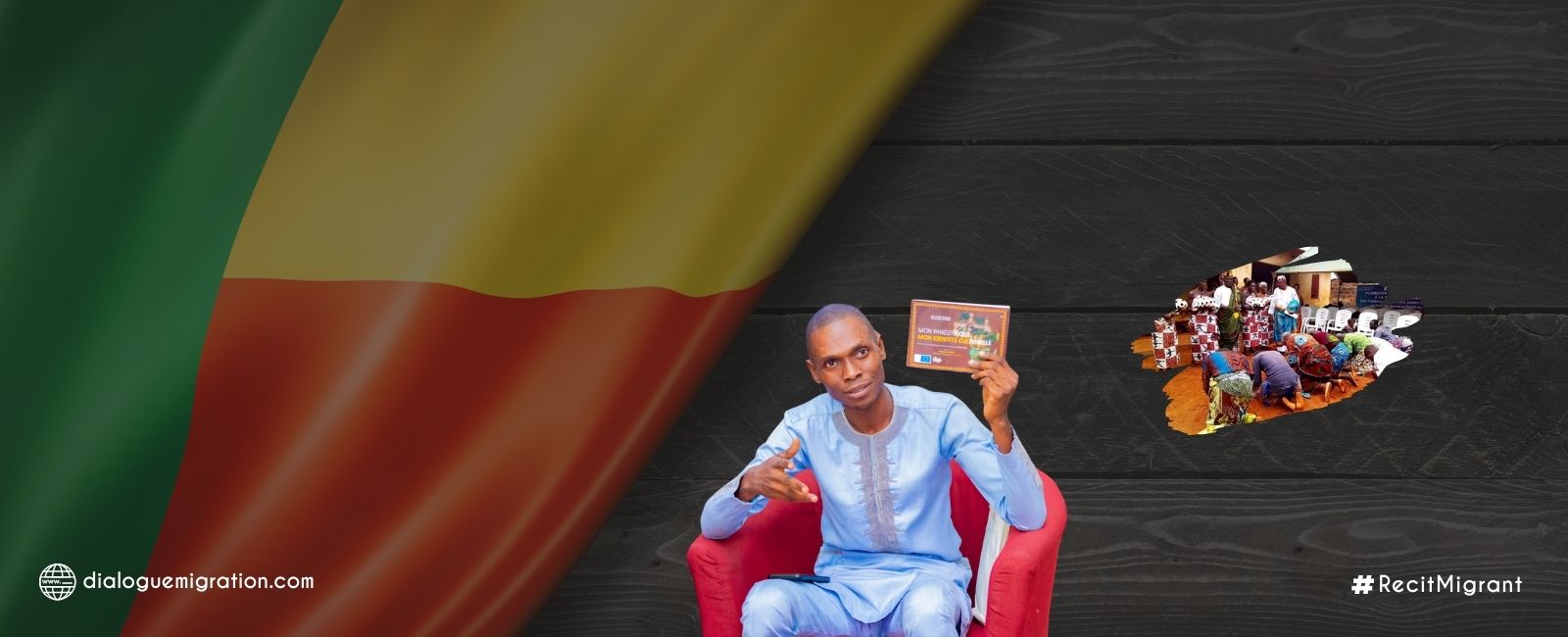

Major player in the publishingchain and in the promotion of intangible heritage in Benin and in the sub-region, through a project called “Mon Panégyrique, Mon Identité Culturelle” (Tribute to my identity”, Camille Sègnigbindé, president of the association Ecrivains Humanistes – Bénin, and coordinator of the said project, has published a paper and audio directory of panegyrics of the “Fon” ethnic group of Abomey and the “Mahi” ethnic group of Savalou” in the south of Benin. He talks with Dialogue Migration about the link between panegyric and migration at the end of his research.
You’ve launched a directory, what is it about?
This is the “Mon Panégyrique, Mon Identité Culturelle” initiative, started in 2022 that perfectly combines literature and performing arts (singing, storytelling, slam) and aims, among other things, to finally identify and recognise the merits of the bearers of clan panegyrics within communities. Also to safeguard this cultural heritage through the publication of a paper and audio directory,, an element of Beninese folklore threatened with extinction, which can be found in other forms elsewhere in the sub-region with the griots. This repertoire, released on Friday, September 22, 2023, is the result of a highly educational process of collection, transcription in Fon language and translation into French. They were then audited for validation in order to transmit them to the younger generation through performing arts in a process of artistic co-creation.
So, what is a clan panegyric?
A clan panegyric is a form of praise for the deeds of a personality, a person, an entity. Generally there are three forms of panegyrics, including royal panegyrics to kings; the cultic panegyrics for the deities and the clan panegyrics. Clan panegyrics are to be praised. And when we speak of praise, we are talking about great deeds, especially the deeds of those who passed before our generation. You can imagine how proud a person might feel upon learning that their ancestor once slew a lionThis gives him a certain courage; Even if he wasn’t the one who did it, there’s a certain pride behind it.
Why are panegyrics essential?
According to scientists (sociologists and linguists) we have interviewed on the subject, there is a certain spiritual vibration that acts rather positively on this entity or person to whom the panegyric is declared. It also contributes to cultural identity, that is, it is spoken about in relation to a clan or a community. This allows you to stand out as a whole in reality and to assert yourself from the great deeds. The clan panegyric confers a sense of pride in connection with the bravery of one’s ancestors. As a result, the person to whom it is declared easily stands out from all the others in reality. This allows him to show himself, to distinguish himself and why not benefit from the positive vibrations of his ancestors, his elders and therefore to face the difficulties that this person may face, including serving as a mediator a couple where he can serve as a mediator to defuse a crisis a couple might be experiencing as well as in all aspects of social life.
From your research, it appears that the collection of panegyrics goes beyond the geographical area listed. What is the link or influence of migration on panegyrics?
The origin of the panegyrics, without going into detail, is a whole story mainly related to migration. And it’s this migration that’s very important. Some kingdoms elsewhere in our country were created from this migration of certain peoples from point A to point B. And so that information traveled with those people. And it can be said today that migration has fostered the information or verses of these panegyrics.
Apart from the deeds mentioned, have there been any conflicts?
Indeed! To be able to evoke the great deeds, it is because there were conflicts and at the end of which these ancestors were able to win, whether it was the enemy or whether it was supernatural circumstances.
So, can we trace the history of a people through panegyrics?
Yes, that’s right. You can trace the origin of a people from the panegyric. That’s why the link with migration is very useful to get the gist of the information through the worms. Panegyrics are conceived in the form of verses and you have stanzas that are condensations of information that can be detached from each other. That is, these stanzas can be independent. They do not necessarily contain dependent information, but rather information that has been traced back in time. For example, for a first king or a tribal chieftain, one takes his deeds, when another comes after him, one takes the deeds of that one, and so on until a certain generation. So it’s a growing set of information. As for the royal panegyrics, when you go to Abomey (one of the most famous kingdoms in the south of the current territory of Benin -editor’s note), for example, each king who accedes to the throne when he is no longer there, we will take his deeds to add them to the panegyrics of that clan and we keep the base. It’s like the verses of a song; It continues.
In view of all that panegyrics represent, how can panegyrics be safeguarded and transmitted?
We have to start with households, we have to start with individuals. We must begin by knowing our own clan panegyrics. It starts from there. Everyone must go and get their clan panegyric. Everyone has them. In other countries, it is narrated and sang by the griots. Once mastered, we can pass it on to our children, to our circle. This is the first step towards easy transmission from generation to generation. The second thing, Professor Bienvenue Akoha said t is also necessary to start at school where poetry and songs are recited”. Also, there are cultural and artistic activities at the school. Already, policymakers can start by including these panegyrics in the educational process. After that, there are shows with the artists who are vectors of transmission. We must already entrust them with this mission of integrating this aspect to create shows. Whether it’s singers, storytellers, slammers and others, they can use this source that we created that they have today which is this repertoire of panegyric to create. This document is available in French and in the Fon language. With this, they can get comfortable in their creative process.
To conclude…
We are happy, and filled with hope, to build the cultural bridge between literature and the other performing arts while putting books at the service of safeguarding Beninese and African cultural heritage. And through this, consecrate the safeguarding and the beginning of a new form of promotion of the Beninese literary genre “Ako” or the panegyric, in particular the clan panegyric “Ako mlanmlan” in the Fon language of southern Benin.
Interview conducted by Ange BANOUWIN


